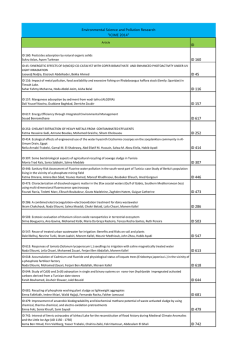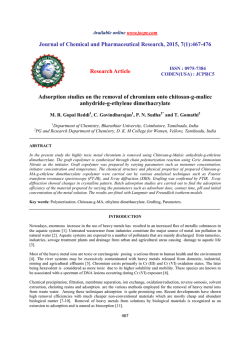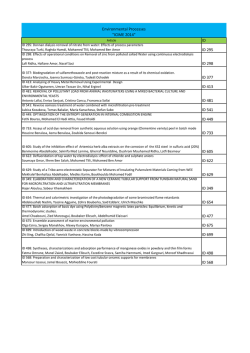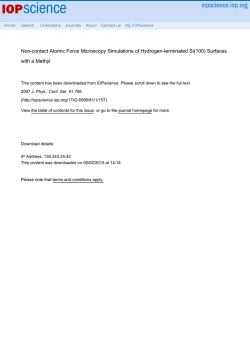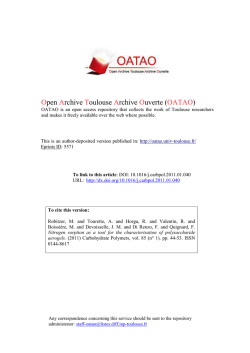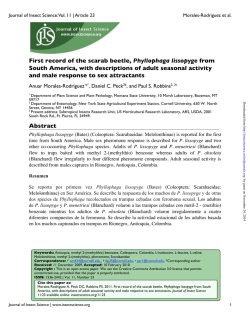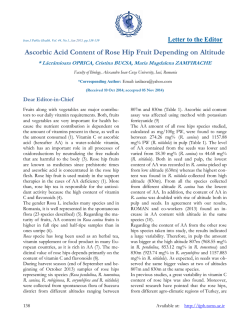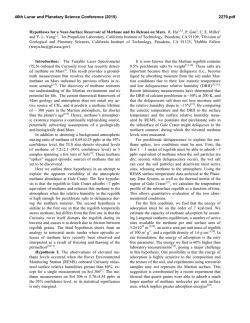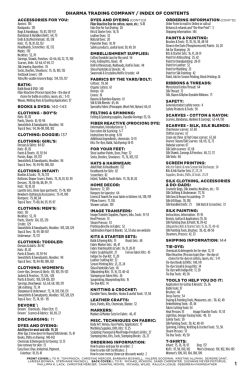
Bioremoval of methyl orange dye using durian fruit
Available online www.jocpr.com Journal of Chemical and Pharmaceutical Research, 2015, 7(1):589-599 Research Article ISSN : 0975-7384 CODEN(USA) : JCPRC5 Bioremoval of methyl orange dye using durian fruit (Durio zibethinus) Murr seeds as biosorbent Zulkarnain Chaidir1, Desvina Trio Sagita2, Rahmiana Zein2* and Edison Munaf2 1 Laboratory of Biochemistry, Department of Chemistry, Faculty of Mathematics and Natural Sciences, Andalas University, Padang, Indonesia 2 Laboratory of Environmental and Toxicological Chemistry, Department of Chemistry, Faculty of Mathematics and Natural Sciences, Andalas University, Padang, Indonesia _____________________________________________________________________________________________ ABSTRACT Methyl Orange Adsorption was studied using Durio zibhethinus Murr seeds. Examined parameters are pH of solution, initial dye concentration, biosorbent mass, stirring speed, contact time, and temperature of heating. The optimum absorption capacity of Methyl Orange is obtained at a concentration of 80 mg/L is 6.352 mg/g at pH=2, 0.05 g biosorbent dose, stirring speed 200 rpm, contact time of 40 minutes and temperature of 50°C. Appropriate adsorption isotherm models namely Freundlich isotherm models with correlation coefficient 0.973. Keywords: Adsorption; Durio zibethinus Murr; Methyl Orange; Biosorbents. _____________________________________________________________________________________________ INTRODUCTION The development of science and technology provides many benefits to human life, but the effects of a negative impact on the surrounding environment, such as industrial waste problems. The case of water pollution occurring in the environment largely caused by the disposal of industrial waste is done freely in the waters without any prior processing.Many industries use dyes in order to colour their products and pour a lot of coloured wastewater into the effluent. The discharge of dye-bearing wastewater into natural streams and rivers from the textile, paper, carpet, leather, distillery and printing industries possesses severe problems [1].Dyes are organic compounds consisting of two main groups of compounds, chromophores (responsible for the color of the dye) and auxochromes (responsible for intensity of the color) [2]. Dyes usually have a synthetic and complex aromatic structure, which makes them more stable and difficult to biodegrade[3]. By absorbing sunlight, dyes can prevent photosynthesis in aqueous ecosystems. Sulfur dyes are harmful to aqueous organisms, since they can rapidly reduce the oxygen content of water [4].This can make the waste water toxic and even mutagenic if degraded by anaerobic digestion. Furthermore, based on regulations for waste colour, a low concentration of visible dye is intolerable and can cause a health hazard for humans. Methyl orange is an anionic molecule. When there is a nitrogen compound in its structure, it becomes an azo-dye that can cause allergies and hypersensitivity [5]. The studies have been performed in order to remove color and other contaminationsusing various types of methods include adsorption[6], coagulation[7], ultrafiltration [8], photodegradation [9] etc., in which adsorption is most usefuldue to its efficiency and visibility. The use of low-cost, easy obtained, high efficiency andeco-friendly adsorbents has been investigated as an ideal alternative to the current expensivemethods of removing dyes from 589 Rahmiana Zein et al J. Chem. Pharm. Res., 2015, 7(1):589-599 ______________________________________________________________________________ wastewater. In recent years, many low cost agricultural wastes such as rice husk[10], mangosteen peels [11], mango seeds[12],coconut fibre [13], walnut shell charcoal [14],tamarind seeds [15],neem leaf [16], loquat leaves [17], banana and orange peels [18]have been investigated as biosorbents. Durio zibethinus Murr seed is another agriculturalby product obtained offrom Durio zibethinus Murr fruit. In the present work, we investigated the efficiency of Durio zibethinus Murr seeds as a low cost biosorbent material for the removal of methyl orange from aqueous solutions. EXPERIMENTAL SECTION Chemicals and apparatus All reagents were used of analytical grade obtained from Merck. The apparatus were used pyrex, an analytical balance, a pH meter (Metrohm), crusher (Fritsch),oven (Memmert, Germany), a shaker (Haake SWB 20), mortal grinding (Fritsch, Germany), FTIR ( Thermo Scientific), UV-VIS spectrophotometer (Genesys 21), and Scanning Elctron Microscoph. Treatment of Durio zibethinus Murr seeds Durio zibethinus Murr seeds are washed with water, then dried. Seeds was dried was crushed and sieved to a particle size of ≤ 160 µm. Then the durian seed powder activated using 0.01 N HCl for 1 hour (1 g Durio zibethinus Murr seed powder in 8 mL of 0.01 N HCl). Durian seed powder was washed with aquadest until neutral pH and then filtered and dried. The seeds powderthen crushed using a mortar and ready to be applied. Dye solution preparation Methyl Orange was made up in stock solution of concentration 1000 mg/L and was diluted to the required concentrations (5- 100 mg/L). FTIR Analysis For the IR studies, 5 % (w/w) of ground and dried of Durio zibethinus Murr seeds before and after used as biosorbent were pressed to form KBr disc. Biosorption studies Adsorption experiment were carried out at various pH of the solution, initial concentration, biosorbent mass, agitation rate, contact time and temperature under batch mode. The pH of the solution was adjusted at range 1-8 by adding NaOH, HNO3and buffer solution at indicated solution of pH placed in 25 mL Erlenmeyer. The Erlenmeyer then were placed on a rotary shaker with constant shaking 250 rpm for 15minutes, and solutions were separated from biomass by using filter paper. After that, the final concentrations were determined spectrometrically at a wavelength corresponding to the pH of the solution (466-510 nm). The adsorption capacity of the biosorbent (q, mg/g) was obtained from Equation. Q= where Co and Ce were initial and equilibrium dye concentration in solutions (mg/L), respectively; V was volume of the solution (L); m was the amount of biomass (g). RESULTS FTIR analysis The spectrum of Durio zibethinus Murr seed biosorbent before and after biosorption can be seen in Figure 2. Durio zibethinus Murr seed biosorbent before absorption (Fig.2a) representating peak of the O-Hat 3393.42 cm-1. After absorption (Fig.2b) that peak was shifted to 3404.26 cm-1. In addition, in the spectrum beforebiosorption there is a C-H at 1370.41 cm-1 and after absorption was shifted to 1375.37 cm-1. The peak of C-O before biosorption at 1022.04 cm-1and after biosorption was shifted to 1020.25 cm-1. At the summit there is a spectrum after adsorption of C=O by CO2 at 2360.18 cm-1, impurities that comes from characterization happen [19]. In this case, the possibility of dye molecules interact with the O-H, C-H and C-O functional groups. The shift in the biosorption peak generally indicates a process of dye interaction with the biosorbent surface. From the FTIR spectrum seed biosorbent, the O- 590 Rahmiana Zein et al J. Chem. Pharm. Res., 2015, 7(1):589-599 ______________________________________________________________________________ H, C-H and C-O functional groups are involved in biosorption process. In addition to observing the shift of peaks, the interaction can also be observed through the change in the intensity of each peaks. Fig 1.(a) Durian (Durio zibethinus Murr) seeds Fig 1.(b) Durian seeds powder 591 Rahmiana Zein et al J. Chem. Pharm. Res., 2015, 7(1):589-599 ______________________________________________________________________________ b a Fig 2. FTIR spectrum of Durian (Durio zibethinus Murr) seeds (a) before and (b) after adsorption Fig 3.(a) SEM of durian seeds before adsorption 320x 592 Rahmiana Zein et al J. Chem. Pharm. Res., 2015, 7(1):589-599 ______________________________________________________________________________ Fig3. (b) SEM of durian seeds after adsorption 320x Adsorption capacity (mg/g) 1.5 1 0.5 0 0 2 4 6 8 pH Fig4. Effect of pH on the absorption capacity of Methyl Orange; volume solution = 10 mL; initial concentration = 20 mg/L; biosorbent dose = 0.1 g; contact time = 15 minutes; agitation rate = 250 rpm; adsorbent particle size ≤ 160 µm 593 Rahmiana Zein et al J. Chem. Pharm. Res., 2015, 7(1):589-599 ______________________________________________________________________________ 5 Adsorption capacity (mg/g) 4 3 2 1 0 0 20 40 60 80 Initial concentration (mg/L) 100 Fig5. Effect of initial concentration on the adsorption capacity of Methyl Orange; volume solution = 10 mL; pH = 2; biosorbent dose = 0.1 g; contact time = 15 minutes; agitation rate = 250 rpm; adsorbent particle size ≤ 160 µm Adsorption capacity (mg/g) 6 4 2 0 0 0.1 0.2 0.3 0.4 Biosorbent dose (g) 0.5 0.6 Fig6. Effect of biosorbent dose on the absorption capacirty of Methyl Orange; volume solution = 10 mL; initial concentration = 20 mg/L; pH = 2; contact time = 15 minutes;agitation rate = 250 rpm; adsorbent particle size ≤ 160 µm 594 Rahmiana Zein et al J. Chem. Pharm. Res., 2015, 7(1):589-599 ______________________________________________________________________________ 6 Adsorption capacity (mg/g) 5 4 3 2 1 0 0 100 200 300 Agitation rate (rpm) Fig7. Effect of agitation rate on theabsorption capacirty of Methyl Orange; volume solution = 10 mL; initial concentration = 20 mg/L; pH = 2; contact time = 15 minutes; biosorbent dose = 0,05g; adsorbent particle size ≤ 160 µm 5 Adsorption capacity (mg/g) 4 3 2 1 0 0 20 40 60 Contact time (min) Fig8. Effect of contact time on the absorption capacity of Methyl Orange; volume solution = 10 mL; initial concentration = 20 mg/L; pH = 2; biosorbent dose = 0,05g; agitation rate = 200 rpm; adsorbent particle size ≤ 160 µm 595 Rahmiana Zein et al J. Chem. Pharm. Res., 2015, 7(1):589-599 ______________________________________________________________________________ Adsorption capacity (mg/g) 6 4 2 0 0 20 40 60 80 Biosorbent heating temperature ( C) 100 Fig9. Effect of biosorbent heating temperature on theabsorption capacirty of Methyl Orange;volume solution = 10 mL; initial concentration = 20 mg/L; pH = 2;biosorbent dose = 0,05g; agitation rate = 200 rpm; contacttime = 40 minutes; adsorbent particle size ≤ 160 µm y=–0,7 95x- 1,183 y = 0,795x 1,183 6 R2 = 0,351 1 R2 = 0,351 ln qe Ce/qe y =0,081x +4,133 y = 0,081x + 4,133 4 0 2 -1 0 0 10 20 0 1 2 3 ln Ce Ce (a) (b) Fig 10.(a) Linearized Langmuir Isotherm (b) Linearized Freindlich Isotherm Scanning Electron Microscopy analysis The SEM analysis was performed to observe the surface morphology of the biosorbents before and after dyes biosorption. Figure 3a shows the surface of the Durio zibethinus Murr seeds biosorbent before biosorption, where the surface is heterogeneous and there are many clots. But after biosorption (Fig.3b) heterogeneous surface become more homogeneous and the clots split into fewer, that demonstrate the interaction has happened between the Durio zibethinus Murr seedsbiosorbent with Methyl Orange dye. Effect of pH of solution The pH has a significant influence on the biosorption process because variation in pH leads to the variation in the surface properties of the sorbent and the degree of ionization [20]. The effect of pH (pH=1-pH=8) on biosorption of 596 Rahmiana Zein et al J. Chem. Pharm. Res., 2015, 7(1):589-599 ______________________________________________________________________________ methyl orange ondurian seeds biosorbent was shown on Figure 4.It was observed that the biosorptions were much higher in acidic solutions than those in natural conditions. As the pH of the system decreased, the number of negatively charges surface sites decreased and the number of positively charged surface sites increased and this favors the biosorption of dye anions due to electrostatic attraction [21].When the acidity increase due to concentration of H+ that will decrease the negative charge for Methyl Orange, then adsorption increases. But, when the basicity of solution was increased, the amount of biosorption is decreased due to the increase of concentration of OH- [22]. In this case obtained the pH optimum biosorption of Methyl Orange dye using Durio zibethinus Murr seeds biosorbent is pH=2. Effect of initial concentration of Methyl Orange The effect of initial concentration are shown in Figure 5,that shows increasing the initial concentration increases the interaction between dye molecules with the Durio zibethinus Murr seeds biosorbent surface. The initial concentration of dye Methyl Orange were observed starting from 5 mg/L to 100mg/L. It was found that the absorption capacity of Methyl Orange rise to a concentration of 80 mg/L, whereas at concentrations greater decrease absorption capacity. This is related to the availability of active sites on the biosorbent surface[23]. When the number of active sites available is greater than the number of dye molecules, the absorption capacity will increase with the concentration of the dye, until the number of active sites is equal to the number of dye molecules or commonly called the equilibrium state. Once past the equilibrium state, the absorption capacity will decrease. Also similar adsorption patterns have also been reported by other researchers [21-22].Haddadian said the initial dye concentrations provide an important driving force to overcome all barriers to movement of dye molecules from the liquid phase to the solid phase [5]. Effect of biosorbent dose Biosorbent dosehavesignificant affect tothe biosorption process. The more biosorbent is used it will be the more active sites of the biosorbent will bind the dye. However, in the present study it was found that the absorption capacity decreases with increasing durian seeds biosorbent dose(Fig.6). This is due to the saturation, another reason may be due to the interaction of particles, such as aggregation caused by high levels of biosorbent dose. These events will cause a decrease in the total surface area of the adsorbent [23]. In this study, the greatest absorption capacity is 6.008 mg/g at 0.05 g biosorben dose. Effect of Agitation Rate Agitation rate observed between 100-300 rpm. In Figure 7 we can conclude that higher the stirring speed increases capacity of absorption. This is due to the movement of dye molecules and the adsorbent particles in solution increases so that the greater the opportunity to collide. However, the absorption capacity will be reduced to a very large mixing speed it will form a vortex that resulted in absorption is unlikely [24]. In this case the obtained optimum stirring speed of 200 rpm. Effect of Contact Time Durio zibethinus Murr seedsbiosorbent is shown in Figure 8.Absorption capacity increased rapidly at the time of 5-15 minutes and counting up to 40 minutes. At the time more than 40 minutes down the dye absorption capacity. Initially, there were large number of vacant active binding sites available at the first phase of experiment and large amount of Methyl Orange were bound rapidly on Durio zibethinus Murr seeds biosorbent at a faster adsorption rate. The binding site was shortly become limited and the remaining vacant surface sites were difficult to be occupied by Methyl Orange due to the formation of repulsive forces between the Methyl Orange on the solid surface and the liquid phase [25]. Effect of heating temperature of biosorbent In Figure 9, it can be seen that the absorption capacity of the biosorbent heating temperature increased to 50°C. While at 70°C and 90°C decreased capacity. This shows that the adsorbent Durio zibethinus Murr seeds can last up to a temperature of 50°C and at higher heating temperatures durian seeds biosorbent damage due to the decomposition of organic compounds that exist in the biosorbent by heating that causes the active site on the surface is reduced so that the number of molecules dye is absorbed into fewer. Desorption Table 1 show that Hydrochloric acid efficiently remove Methyl Orange from durian seeds biosorbent.From the table we can see that the largest percentage of desorption is by using 0.1N HCl is up to 41.28%, so it can be concluded 597 Rahmiana Zein et al J. Chem. Pharm. Res., 2015, 7(1):589-599 ______________________________________________________________________________ that 0.1 N HCl is better for desorption process ofMethyl Orangeat the durian seeds biosorbent. Biosorbent of desorption product which has been dried and can be reused for secondbiosorptin process. Where the results of adsorption were carried out with all the optimum conditions contained in the Table 2. Biosorption percentage using the regenerated durian seeds biosorbent is smaller than the durian seeds biosorbentthat have not been contacted. This is because most of the active site was first occupied by the dye molecules are not separated during the desorption process. Adsorption Isotherm In this study selected two adsorption isotherm models namely the Langmuir isotherm models and Freundlich isotherm models. The applicability of the isotherm models to the adsorption study done was compared by judging the correlation coefficients, R2 values. This will show how adsorbed moleculesdistribute between the liquid phase and the solid phase when the adsorption process reaches an equilibrium state. The analysis of the isotherm data by fitting them to different isotherm models is an important step to find the suitable model that can be used for design purposes [26]. Langmuir isotherm Langmuir isotherm where assumptions on the adsorption mechanism are that the adsorption occurs at homogeneous surface within the adsorbent and the adsorption at one site does not interfere with the ability of the next side to adsorb dye. Langmuir isotherm models that have been applied to some of the adsorption process is described by the following equation: Ce 1 1 = + C q e Q0 b Q0 e C e = concentration of dye after equilibrium (mg / L) q e = amount of dye adsorbed per gram of adsorbent (mg / g) Q 0 = maximum adsorption capacity (mg / L) b = energy of adsorption A plot of Ce/qe versus Ce produces a straight line which indicates homogeneous adsorption distribution of Langmuir isotherm [27]. The values of constant b and Q0 were obtained from the intercept and the slope of the graph as shown in Figure 10a. Freundlich isotherm The Freundlich isotherm can be used for adsorption that involves heterogeneous surface energy systems [28]. The equation is expressed as: 1 q e = K FCe n Where KF and n are Freundlich constants, KF (mg/g (L/mg)1/n) is the adsorption capacity of the sorbent and n giving an indication of how favorable the adsorption process. If the value of exponent n was greater than 1 (n >1) then the adsorption represent favorable adsorption condition [29]. The constants KF and n can be determined from the linear form of Freundlich isotherm equation from the graph of ln qe against ln Ce as expressed from the following equation: ln q e = ln K F + 1 ln C e n In general, as the KF value increases the adsorption capacity of adsorbent will also increase [27]. The intercept and slope of the plot of ln qeversus log Ce (Fig. 10b) were used to calculate the values of ln kF and 1/n, respectively. Table 3 shows that the values of R2 were in the range of 0-1, which confirms the favorable adsorption of the Methyl Orange dye. The values of the correlation coefficient (R2) indicate that the experimental data were more suitable to the Freundlich isotherm than Langmuir isoterm models and this indicating the heterogenous nature of durian seeds 598 Rahmiana Zein et al J. Chem. Pharm. Res., 2015, 7(1):589-599 ______________________________________________________________________________ biosorbent [30]. Freundlich model shows that the value of n was greater than 1 which represents a favorable adsorption condition. CONCLUSION The process of adsorption of Methyl Orange using durian (Durio zibethinus Murr) seeds powder that have been activated with 0.01 N HCl can be as low cost and high efficiencybiosorbent to reduceMethyl Orange dye in solution. The optimum conditions of Methyl Orange dye adsorption that at pH=2, 0.05 g biosorbent dose, stirring speed 200 rpm, contact time of 40 minutes and temperature of 50°C is obtained as the value of the optimum absorption capacity of 6.352 mg/g. FTIR data analysis representating some shifts in the wavenumber O-H, C-H and C-O group functional. This indicates that the functional groups are involved in the process of Methyl Orange dye adsorption by the durian seeds biosorbent. REFERENCES [1] RC Torane, KS Mundhe, AA Bhave, GS Kamble, RV Kashalkar, NR Deshpande. Der Pharma Chemica. 2010,2(3),171-177 [2] R Christie. The Royal Society of Chemistry. 2001 [3] E Sayan. Chem Eng J, 119. 2006,175-181 [4] S Aber, N Daneshvar, SM Soroureddin.Desalination. 2007, 211, 87-95 [5] Z Haddadian, AS Mohammad, ZA Zurina, FR Ahmadun, HIS Mohammad.Chemical Science Transactions. 2013, 3, 900-910 [6] KS Mundhe.Journal of Chemical and Pharmaceutical Research.2012, 4, 423-436. [7] R Marandi, MBS Seyedeh.American Journal Of Environmental Engineering.2011,1,1-9. [8] K Majewska.J. Environ. protection eng.2005, 31, 3–4. [9] M Visa.J. Catalysis today.2009, 144, 137–142. [10] EMunaf, RZein.Environ.Technol.1997, 18(3), 359-362. [11] RZein, RSuhaili, FEarnestly, Indrawati, E Munaf.Journal of Hazardous Materials, 2010, 181, 52-56. [12] J Lameira, NA Cláudio, SA Wagner, A Elie, CL Betina R, FS Felipe.Chemical Engineering Journal, 2012, 209, 577–588. [13] YC Wong, MSR Senan, NA Atiqah.Journal of Basic & Applied Sciences.2013,9, 172-177. [14] TPS Sumanjit, T Walia, I Kansal.J. Surface Sci. Technol.2008, 24(3-4), 179-193. [15] H Patel, RT Vashi.http://www.e-journals.net.2010, 7(3), 975-984. [16] Khatod.International Journal of ChemTech Research.2013, 5(2), 572-577. [17] AM Awwad, NM Salem.Journal of Chemical Engineering and Materials Science.2012, 3(1), 7-17. [18] S Kamsonlian, S Suresh1, CB Majumder, S Chand. International Journal of Science Technology & Management.2011, 2(4), 1-7 [19] LD Pavia, ML Gary, SK George,RV James. Introduction to Spectroscopy Fourth Edition, 2009 Brooks/Cole Cengage Learning. [20] VK Gupta,R Jain, S Varshney, VK Saini. J. Colloid Interface Sci. 2007, 307, 326-332. [21] N Prasanna,V Manivasagan, S Pandidurai, D Pradeep, SS Leebatharushon.International Journal of Advanced Research.2014, 2, 341-349. [22] US Saed, HA Mohammed, AA Ahmed.Second Scientific Conference, 2012. [23] S Xing, Z Meiqing, M Zichuan.Journal of Environmental Sciences.2011,9,1497–1502. [24] BS Prakash, S Vasanth K. International Journal of ChemTech Research CODEN (USA).2013, 5, 1254-1262. [25] J. Anwar, U. Shafique, Z. Waheed, M. Salman, A. Dar, S.Anwar.Bioresource Technology.2010, 101(6), 17521755. [26] IAW Tan,AL Ahmad,BH Hameed.Desalination, 2008, 225, 13-28. [27] NZ Rebitanim, WAKG Wan Azlina,KM Dalia,R Nur Akmal, A Mohamad, M Salleh.Journal of Purity, Utility Reaction and Environment.2012, 1, 45-60. [28] PK Malik. Journal of Hazardous Materials.2004,113(1-3), 81-88. [29] CNamasivayam, R Jeyakumar, RT Yamuna.Waste Management.1994,14(7), 643-648. [30] M Salleh, MAmran, KM Dalia,AA Enas. J. Advanced Scie and Eng. Res.2011, 1, 76-97. 599
© Copyright 2025
